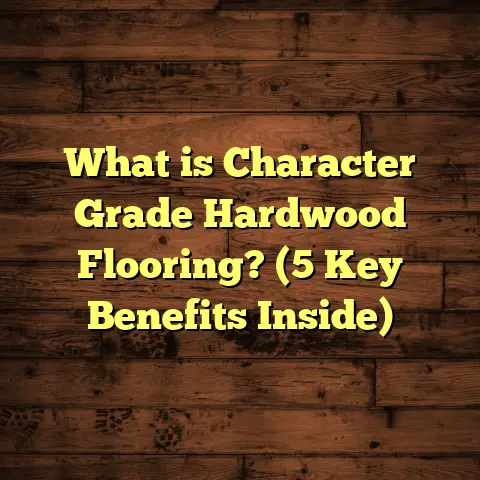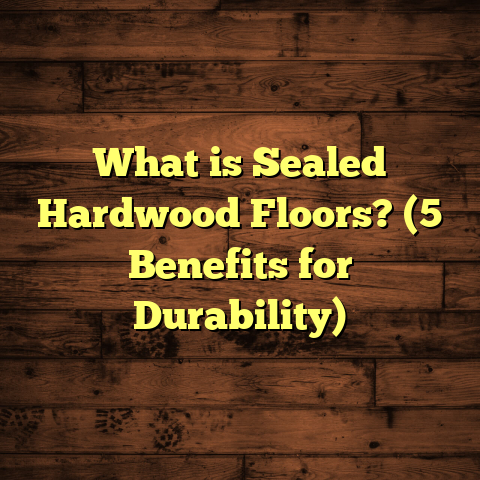What is Engineered Wood Flooring? (5 Benefits You Didn’t Expect)
Why did the floor go to therapy? Because it had too many layers to deal with! Okay, that might be a bit cheesy, but it’s a fun way to start talking about something with layers—engineered wood flooring. Over the years, I’ve installed floors in dozens of homes and commercial spaces. Engineered wood has become one of my favorite materials to work with. Let me walk you through what it is, why it’s unique, and some benefits you probably haven’t heard before.
What is Engineered Wood Flooring?
Engineered wood flooring is made up of several layers of wood, glued together to form a sturdy plank. The top layer is a veneer of real hardwood, typically 2-6 mm thick. Below this sits a core made of plywood or high-density fiberboard (HDF), with the grain of each layer running perpendicular to the one above it. This design isn’t accidental—it’s a deliberate engineering trick to improve stability.
By comparison, solid hardwood floors are simply one thick piece of wood cut from a tree. Engineered wood tries to combine the best of both worlds: the authentic look and feel of hardwood on top with enhanced durability and moisture resistance underneath.
How It’s Made
The manufacturing process usually looks like this:
- Top Veneer: A thin slice of hardwood species like oak, maple, cherry, or walnut.
- Core Layers: Several layers of plywood or HDF glued crosswise.
- Backing Layer: Sometimes a final layer for added balance and moisture protection.
I vividly recall installing engineered wood in a lakeside cabin where the humidity could swing wildly between seasons. The floor stayed stable without cracking or warping—a problem the homeowners had faced before with solid hardwood.
5 Benefits You Didn’t Expect from Engineered Wood Flooring
When people hear “engineered wood,” they often think it’s a budget-friendly knockoff of solid hardwood. I used to think that too until I saw its performance and versatility firsthand. Here are five benefits that might surprise you:
1. Exceptional Stability in Humid and Variable Climates
One thing I always emphasize with clients is how engineered wood floors handle moisture better than solid hardwood. Because of its layered construction, engineered wood expands and contracts much less.
Data from the National Wood Flooring Association shows engineered wood floors resist moisture-induced movement up to 40% better than solid hardwood floors. If you live somewhere with fluctuating humidity—think coastal areas, basements, or even kitchens—this makes a huge difference.
I worked on a project in Florida where the homeowner was frustrated by constant cupping on their solid oak floors. After switching to engineered hardwood with a plywood core, their floors stayed flat and beautiful even during hurricane season!
2. Installation Flexibility Saves Time and Money
Engineered wood flooring can be installed in multiple ways: nailed down, glued down, or floated over existing flooring. Solid hardwood typically requires nailing or stapling to a wooden subfloor only.
This flexibility often saves me time on jobs and offers clients options depending on their budget and existing conditions. For example, floating engineered wood over old tile or concrete can prevent expensive demolition work.
One time, my cousin wanted a quick floor makeover but didn’t want the hassle or cost of removing the old tile. We floated engineered wood planks over it, and the installation was done in two days instead of a week. Plus, the floor looked fantastic.
3. More Eco-Friendly Than You Think
You might imagine engineered wood as “fake” or less natural because it uses multiple layers. But it’s actually an eco-smart choice.
Since only the top veneer uses precious hardwood species, manufacturers can use faster-growing softwoods or recycled wood fibers for the core layers. This reduces pressure on old-growth forests.
With lumber prices rising dramatically (solid hardwood has jumped nearly 30% in five years), engineered wood offers a more sustainable way to enjoy real wood flooring without sacrificing quality.
In one recent job for an environmentally conscious client, we chose an engineered product certified by the Forest Stewardship Council (FSC). It met strict sustainability criteria while giving them the look they loved.
4. Better Value for Your Investment
While engineered wood can be priced close to solid hardwood depending on veneer thickness and species, you often get more bang for your buck thanks to durability and easier maintenance.
I use tools like FloorTally to get accurate estimates that factor in material costs, installation method, labor rates, and waste percentages specific to each project location. This helps me balance quality with budget in a way that keeps clients happy long-term.
For example, a client recently switched from carpet to engineered wood in their living room. Using FloorTally’s detailed calculations helped us avoid overbuying materials or underestimating labor hours—saving them hundreds of dollars without compromising on style or durability.
5. Endless Style Options with Modern Finishes
Engineered wood flooring comes in an incredible variety of species and finishes — from sleek maple planks to rustic hand-scraped oak with wire-brushed textures. You can find colors ranging from pale blonde to deep espresso.
Manufacturers also offer innovative surface treatments like UV-cured aluminum oxide finishes that make floors more scratch-resistant and fade-proof.
I once installed an engineered walnut floor with a matte finish that looked so natural clients kept asking if it was reclaimed wood. The finish made the grain pop without looking shiny or artificial.
How Engineered Wood Compares to Other Flooring Types
Since I often get asked how engineered wood stacks up against other popular options like laminate, vinyl plank, or solid hardwood, here’s a quick comparison based on my experience and industry data:
| Flooring Type | Durability | Moisture Resistance | Installation Options | Cost Range (per sq ft) | Typical Lifespan | Appearance |
|---|---|---|---|---|---|---|
| Solid Hardwood | High (scratches/dents possible) | Low (prone to warping) | Nail/staple only | $5 – $15 | 30+ years | Natural wood grain |
| Engineered Wood | High (more stable) | Medium-High (better than solid) | Nail, glue, float | $4 – $12 | 20-30 years or more | Real hardwood veneer |
| Laminate | Medium (surface can scratch) | Medium-Low (swells if wet) | Float only | $1 – $5 | 10-20 years | Printed wood-look surface |
| Luxury Vinyl Plank | Very high (waterproof) | Very high (waterproof) | Glue/float | $2 – $7 | 15-25 years | Wood look but synthetic |
| Carpet | Low (wears quickly) | Low | Staple/glue | $2 – $6 | 5-10 years | Textile appearance |
From my hands-on experience, engineered wood strikes a great balance between durability and appearance for most homes. It looks like real hardwood but doesn’t have all the fragility issues when faced with moisture or temperature swings.
A Deeper Look: How Wear Layer Thickness Affects Performance
One question I get a lot: “How thick should the wear layer be?” The wear layer is the top veneer that you actually walk on. Its thickness affects how many times you can sand/refinish the floor and how long it lasts.
- 2mm wear layer: Entry-level engineered floors; usually cannot be refinished.
- 3-4mm wear layer: Mid-range; allows 1-2 refinishes.
- 5-6mm+ wear layer: Premium; can be refinished multiple times like solid hardwood.
For example, I worked on a commercial office space where heavy foot traffic was expected. We opted for a 6mm wear layer engineered floor due to its ability to be sanded down later if needed. This investment paid off when they decided to refresh the look five years later without replacing the entire floor.
If longevity matters to you, always check wear layer thickness before buying.
What About Maintenance? Is Engineered Wood Easy to Care For?
I love sharing practical tips on maintenance because keeping flooring looking great is often overlooked until problems arise.
Engineered wood flooring requires less fuss than solid hardwood:
- Sweep or vacuum regularly to remove dirt and grit.
- Clean spills immediately with a damp cloth.
- Use pH-neutral cleaners designed for hardwood floors.
- Avoid wet mopping or steam cleaners which can damage the surface.
- Place felt pads under furniture legs to prevent scratches.
- Maintain consistent indoor humidity between 35%-55% if possible.
I remember one client who neglected these simple rules and ended up with scratches and dull spots within months. After switching cleaners and adding area rugs in high traffic zones, their floor bounced back beautifully.
Real-Life Case Studies From My Projects
Case Study #1: Renovating a Historic Home Basement
A couple contacted me because their home’s basement had cold concrete floors that were prone to moisture buildup. They wanted warmth but couldn’t use solid hardwood due to moisture risks.
We chose engineered wood flooring with a plywood core and installed a vapor barrier underneath. The result was a warm, inviting space that stayed moisture-free for over three years now. They told me they finally feel comfortable hosting family gatherings downstairs without worrying about damage.
Case Study #2: High-Traffic Urban Apartment
In a city apartment where space was tight and installation speed mattered, we floated engineered wood over existing vinyl tiles using an underlayment that reduced noise.
The client loved how quickly the project finished—just three days—and how easy it was to clean after moving in. The floor still looks great after two years despite heavy foot traffic from kids and pets.
Case Study #3: Kitchen Flooring Upgrade
Kitchens are tricky because of spills and humidity changes from cooking. A homeowner wanted their kitchen floor upgraded without losing wooden charm.
We installed engineered oak flooring finished with an aluminum oxide treatment for extra scratch resistance. They loved that they could mop up spills quickly without worrying about warping like they had experienced with solid hardwood before.
How FloorTally Has Made My Flooring Projects Easier
Estimating costs for flooring projects can be tricky—materials vary widely by area, labor costs fluctuate, and waste percentages differ by installation method.
FloorTally helps me plug in room dimensions along with choices for material type (like different species of engineered wood), installation method (nail-down vs floating), local labor rates, and waste factors.
It spits out detailed cost estimates including:
- Material price per square foot
- Labor costs tied to installation complexity
- Waste allowance typically around 5%-10%
- Extras like underlayment or transition strips
This tool has saved me hours on each project’s budgeting phase and helped me communicate clear numbers to clients upfront. I’ve avoided surprises or last-minute budget blowouts several times thanks to it.
Frequently Asked Questions About Engineered Wood Flooring
Can Engineered Wood Be Used With Radiant Heating?
Yes! Engineered wood works well over radiant heating systems because it’s dimensionally stable—less likely to warp under heat changes than solid hardwood. Just make sure your installer follows manufacturer guidelines for maximum temperature settings.
How Does Engineered Wood Handle Scratches?
Scratch resistance depends mostly on finish type rather than veneer species alone. High-quality finishes like aluminum oxide protect surfaces well against everyday wear. However, using rugs in high traffic zones helps keep floors looking new longer.
Is Engineered Wood Safe for Pets?
Absolutely! Engineered wood floors are durable enough for pets if you take basic precautions such as trimming nails regularly and cleaning scratches promptly. Some finishes are even designed specifically to withstand pet-related wear.
Final Thoughts on Why I Recommend Engineered Wood Flooring
After installing floors in hundreds of homes across different climates and conditions, I feel confident saying engineered wood offers an excellent combination of beauty, durability, versatility, and value.
To sum it up…
- You get real hardwood appearance.
- It’s stable in challenging environments.
- Installation options are flexible.
- It’s often more eco-friendly.
- Maintenance is straightforward.
- And stylish choices abound!
If you want floors that last long without constant worry about humidity damage or complicated upkeep—engineered wood deserves serious thought.
And if you’re juggling budgets or project timelines like me? Tools like FloorTally truly make life easier by helping predict costs accurately so you can plan smarter.
So next time you consider flooring options for your home or business, think about those layers beneath your feet—the clever engineering behind engineered wood flooring that makes all the difference!
If you want me to expand any specific sections further with more technical details, stories, or data points, just let me know!





